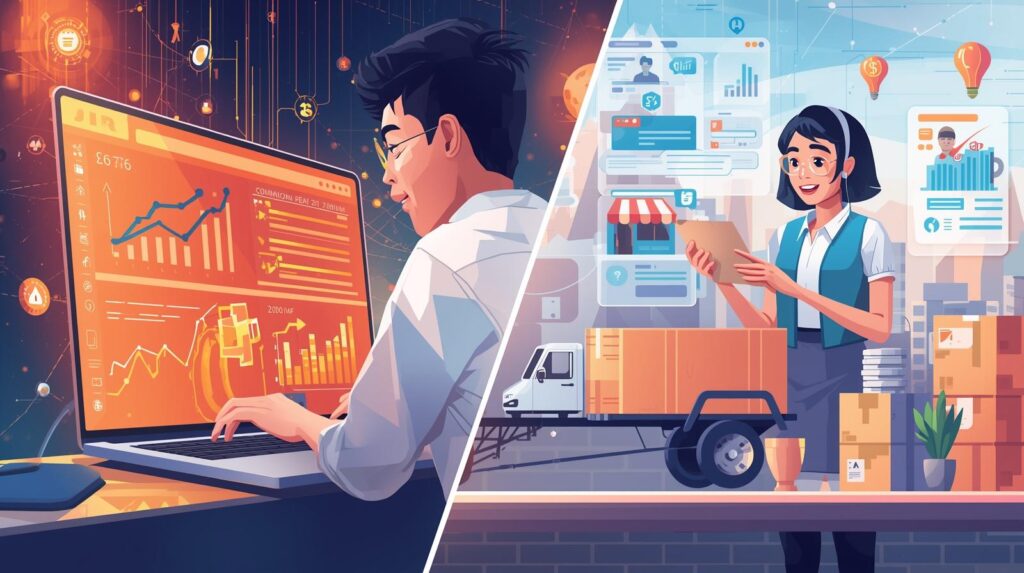Introduction
If you’ve been thinking about starting an online business in 2025, chances are you’ve already heard about two popular options: affiliate marketing and dropshipping. Both are often promoted as “low-cost” or even “no-cost” business models. But here’s the real question everyone asks: which one actually makes more money this year?
Well, let’s dive in together. I’ll explain the differences, the pros and cons, and even share how the latest methods in 2025 are changing the game. Think of this less like a textbook breakdown and more like a friend walking you through the options over a casual chat.

What Affiliate Marketing Really Is (and Why People Love It)
Affiliate marketing is simple at its core: you promote someone else’s product or service, and when someone buys through your special link, you earn a commission.
You don’t deal with shipping, refunds, or customer complaints. Your only job is to get people to click your link and make a purchase. Platforms like Amazon Associates, ShareASale, Impact, and software affiliate programs are packed with opportunities.
The good news is, in 2025, this model has become even more beginner-friendly. Thanks to AI search engines and content platforms, you can rank articles, videos, and even podcasts more easily. Just like checking your 8171 web portal for payment tracking or online confirmation, affiliate dashboards also let you check commissions in real-time. That transparency makes it easier to see what’s working.
The problem is, commissions vary widely. Physical products often pay low rates (3–10%), while digital products or SaaS tools can pay 30–70%. So your income depends a lot on what niche you pick.
What Dropshipping Actually Looks Like in 2025
Dropshipping is like running an online store without buying inventory upfront. You list products on your site, someone orders, and your supplier ships directly to the customer. You pocket the difference between your selling price and the supplier’s price.
Sounds amazing, right? No warehouse, no bulk orders. But here’s the catch: you’re responsible for everything that happens after the order. If shipping is late, if products are damaged, or if customers want refunds—you’re the one answering emails at 2 AM.
In 2025, dropshipping is tougher than it used to be. Customer expectations are sky-high. Thanks to Amazon and same-day delivery, waiting 2–3 weeks for a package is a dealbreaker for most people. That means dropshippers must either find suppliers with faster shipping (like local warehouses) or risk bad reviews.
But the upside? When done right, dropshipping gives you full control over pricing and branding. You’re not just recommending a product—you’re creating a business identity around it.
Quick Comparison Table
Here’s a side-by-side view to make things clear:
| Feature | Affiliate Marketing | Dropshipping |
|---|---|---|
| Startup Cost | Almost zero, free to begin | Low, but you’ll need a web store subscription |
| Control Over Pricing | None (brand sets it) | Full control over profit margins |
| Customer Service | Not your headache | 100% your responsibility |
| Payment Tracking | Easy dashboards, like online confirmation | Through e-commerce + supplier updates |
| Risk Level | Very low | Higher (refunds, chargebacks, delays) |
| Income Potential | Passive, scales with traffic + commissions | Active, scales with ads + customer handling |
| Learning Curve | Focus on content + SEO | Focus on store management + ads |
Which One Makes More Money in 2025?
Let’s be honest. Both models can make money. But the kind of money—and how you earn it—differs.
- Affiliate Marketing: You might not hit $10,000 a month in your first year, but it builds slowly and steadily. Think of it like planting seeds. With the right traffic (blogs, YouTube, TikTok), those seeds can grow into long-term passive income. Some affiliates earn $500 a month, while others pull in $50,000+. The difference is mostly consistency, niche, and strategy.
- Dropshipping: You can make big sales fast if you find a trending product and run good ads. It’s possible to earn $10,000 in a single month—but it’s also possible to lose money on ads and refunds. It’s more like a roller coaster: high highs, but stressful lows.
In fact, many entrepreneurs start with affiliate marketing first because the risk is so low. Once they understand traffic and conversions, they sometimes move into dropshipping to test higher-profit opportunities.
The Latest Methods Changing the Game
2025 is different from 2020 or even 2023. The online business world has shifted a lot, and both affiliate marketing and dropshipping have new tricks.
For Affiliate Marketing:
- AI-driven SEO: Content isn’t just ranking on Google; AI platforms like Perplexity and ChatGPT-style search engines are pulling affiliate content into answers. That means well-structured FAQs and clear explanations can get your links more visibility.
- Micro-influencer power: Even small social accounts with 1,000–5,000 followers can bring in consistent affiliate sales if they’re in the right niche.
For Dropshipping:
- Local suppliers: More dropshippers now use suppliers with warehouses in their target country to cut shipping times.
- Niche branding: Instead of selling random trending products, the latest method is to build a branded store around a specific category (like eco-friendly kitchen gadgets). That builds trust and helps long-term sales.
So what happens is—you need to stay updated with the latest methods if you want to succeed in either model.
My Personal Insight
Here’s my take: affiliate marketing is like checking your CNIC status on a government web portal—it’s simple, clear, and doesn’t put you at much risk. Dropshipping, on the other hand, is like running the whole system behind that portal—you’ve got more control, but also way more responsibility when things go wrong.
Personally, if I were starting fresh in 2025 with no budget, I’d go with affiliate marketing. It’s safer, easier, and teaches you the fundamentals of online business: traffic, trust, and conversions. Once you master those, you can always explore dropshipping later.
Final Words
So, which one actually makes more money in 2025—affiliate marketing or dropshipping?
The truth is, affiliate marketing tends to create steadier passive income, while dropshipping can create faster but riskier cash flow. If you want long-term freedom without customer headaches, affiliate marketing is the way to go. If you’re okay with managing a full-on e-commerce business and want higher control, dropshipping could work.
At the end of the day, it’s not about which model is “better.” It’s about which one fits your personality, skills, and goals.
FAQs
1. Which is easier for beginners in 2025—affiliate marketing or dropshipping?
Affiliate marketing. It has less risk and fewer moving parts.
2. Can dropshipping still make serious money now?
Yes, but only if you use local suppliers and focus on branding. Otherwise, shipping delays will kill your store.
3. How long does it take to earn with affiliate marketing?
Usually 3–6 months of consistent content before you see steady commissions.
4. Do I need upfront investment for affiliate marketing?
Not really. You can start free on social platforms, but having a blog or YouTube channel speeds things up.
5. Which one is more passive in the long run?
Affiliate marketing. Dropshipping always requires store management and customer support.

Leave a Reply